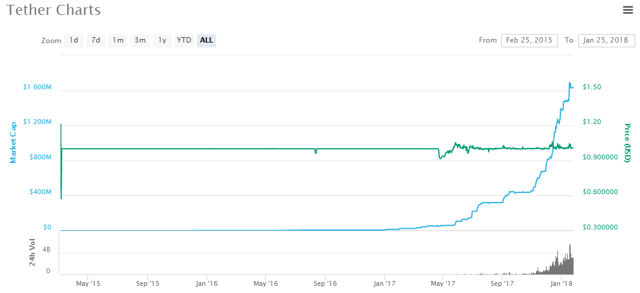Summary
Bitcoin has already dropped 50% from its high just a few short weeks ago, it will continue to drop.
The Bitcoin crash will bring down all cryptocurrency and blockchain related investments.
After the crash and consolidation period, the best uses of cryptocurrency and blockchain technology will rise.
Introduction
Bitcoin's rapid rise in the second half of 2017 has caused it to not only become a topic of worldwide discussion but has also caused some people to throw their entire life savings into the cryptocurrency market. The fear of missing out has people mortgaging their house to buy Bitcoin.
But what exactly is the use of Bitcoin?

Bitcoin – Currency or Commodity?
Bitcoin is simply not useful for common transactions and is already being removed from many payment processors, like Stripe, as it is too slow and costs too much in fees.
The most obvious way to see this as true is to just read this article which states that the 2018 North American Bitcoin Conference in Miami has stopped accepting Bitcoin as an option for ticket purchases
Bitcoin’s obsolete code can only allow a maximum of 7 transactions per second. Compare that to a coin with better coding, EOS, which can handle 50,000 per second or a legacy network such as Visa's (V) which can handle 56,000.
Attempts at increasing the Bitcoin network have failed. The Segwit code was announced to much hype back in August of 2017, but it failed to be adopted.
Now we have a new scheme, called Lightning, which is another endeavor to fix Bitcoin by taking the transactions off the main chain and bundling them up before putting them back on to the main chain. These bundles could hold many transactions, but only be counted as one thereby lessening the load. Many users do not like this idea because the whole point is to keep all transactions on the main chain for accountability.
It is all just tinkering with a network that has these large inherent problems is akin to putting a band-aid on a broken leg.
If it is not used as a currency, could Bitcoin be used as a store of value – a digital gold?
Possibly.
If Bitcoin is just being held and rarely exchanged then the network speed and cost is much less of an issue.
But what would the value be in this situation? Surely the price would stabilize slightly above the cost of creation.
This article did the math and calculated that the cheapest production cost of Bitcoin in the United States is in Louisiana - $3,224.
Manitoba, Canada has caught the eye of Chinese miners after China has clamped down on cryptocurrency mining operations. Manitoba has an electricity price of 3.94 cents per Kwh, half of Louisiana’s.
18 months ago, cloud mining company Genesis said that it cost them $400 plus overhead to mine one Bitcoin. Costs have only gone up since then.
Putting these numbers together and we can reasonably calculate a current production cost of $800-1,800 per Bitcoin in the most favorable areas of the world.
As a digital commodity asset, it might find support in a range of $1-2K.
Crash – The “Crypocalypse”
There are two ways this can go.
The unlikely way is that the price of Bitcoin continues to escalate and more mining rigs are added as the profit margin is high. This spirals upward until Bitcoin reaches $1 million dollars when the mining process consumes the entire world’s energy output.
That or people realize that Bitcoin is actually not very useful or special at all. Other faster and cheaper options exist.
This causes the price of Bitcoin to decrease slowly and then all at once as people run for the exits (7 at a time please) and hitting a level between $1,000-$2,000 USD. Unprofitable mining operations shut down, leaving only the lowest cost producers running the show.
Which way seems more likely?
Add in the very questionable actions by Tether Limited, as discussed in this Seeking Alpha article, which claims that Tether cryptocurrency is being artificially created to purchase Bitcoin and prop up the price. The author states when the fraud is discovered it will bring down Bitcoin.
That article was published on December 4th and the supply of Tether has doubled since then.

Signs point to the good times being over, the future does not bode well for Bitcoin at current prices.
Prices have already dropped by 50% since the high. The upcoming Bitcoin crash will cause the entire cryptocurrency market to go down with it.
The damage will spill over to the stock market. Cryptocurrency mining stocks will be devastated. Even blockchain technology companies, like BTL Group (OTCPK:BTLLF), that have no link to cryptocurrency will see their share prices decrease during the crash.
Rise of Utility Competitors
But from the ashes of the crypocalypse rise the cryptocurrencies with the most useful characteristics and much fewer energy costs.
The crash is a good thing. The hollow coins created by scam artists to get rich quick and those with no use or utility need to disappear. The cryptocurrencies that provide utility need to be separated from the masses of worthless tokens.
Some of the best ones with plenty of utility are ETH, EOS, NEO, and STEEM. IOTA might find a space of its own too. Other tokens will fill specific niches. Monero and Verge coins could compete for the anonymous transactions market, for example.
Less energy intensive proof of stake tokens take the cryptocurrency reigns over those requiring proof of work.
The cryptocurrency field will belong to coins and tokens that can have applications built upon their network.
STEEM is very interesting as it has created its own social network ecosystem, complete with different apps all using the same blockchain. STEEM blockchain clones of YouTube, Twitter, Instagram, and the original blogging page, Steemit.com, all reward the content creator with STEEM coins based off a community consensus of value by 'liking' or upvoting the content they enjoy.
To only use Blockchain technology as a speculative trading instrument is the lowest-level use. Look for more innovative cryptocurrency reward applications like this in the future.
Additionally, money has been thrown at ICO's with moonshot promises and little chance at delivering. However, while most of these will fail, we might see a small percentage succeed that otherwise would never have been funded without this massive hype.
Another area in its infancy is in national cryptocurrencies. Fiat money, already mostly in the electronic realm, will become cryptocurrencies as Central Banks transition national currencies to the blockchain. The common person will be able to transfer money between accounts in mere seconds instead of days. ACH transfers and the like will no longer be used.
It will be the money for the digital future, much like what payment processor QIWI (QIWI) is likely creating in Russia for the newly announced cryptoruble that uses the underlying Ethereum technology. Money that is both a currency and a platform for integrated digital economies.
In the future, Bitcoin becomes a somewhat of a relic but is traded between die-hard believers who pray for the day it returns to glory.
Conclusion
Bitcoin, like any technology, is now obsolete and is already well on its way towards $1,000 where it was trading only one year ago. That is the true price of a rational consensus before mass speculation sent it into the stratosphere.
It failed as a currency but will stick around as an asset and the crash will bring down the entire cryptocurrency market.
The crash will also ruin those who went all-in too late and many people might never return to this market that burned them so intensely.
You can already see this with the collapse of the Ponzi scheme Bitconnect which had promised large daily gains. It closed up shop the other week and thousands of people found out their tokens had dropped in value by 80%+ in a few hours. The Bitconnect subreddit was filled with posts about how they have lost everything and even their spouse wants a divorce.
What really hits the point of a cryptocurrency bubble is that these worthless Bitconnect tokens are continuing to be traded and it still has a market cap of over $120 million dollars.
However, cryptocurrency is here to stay.
The crash will be good for the health of the technology going forward. It will cleanse the fragmented market by reducing weak cryptocurrencies to zero or near enough to be irrelevant. After a consolidation period of undetermined length, the stronger cryptocurrencies will begin to rise again.
I am in no way against cryptocurrencies or blockchain technology. In fact, I will be watching and waiting for the time to buy in again. I am also grateful that Bitcoin pioneered the mass adoption of this technology.
But everything has a cycle. A boom and bust.
No matter how excited you are about a new investment, it is important to not get caught up in the hype and then buy in at an unreasonable price. It is also important to know when to sell.
Hardcore Bitcoin believers will shout that it is "not a bubble" and that “this time is different.”
No, it is never different.

And wat do you think about this ?

There is certain probability to it happening, but I don't think it's just yet.
We have seen price declines like this before:
Longest so far price decline lasted for 626 days - 2013-12-01 to 2015-08-19 (Mt. Gox theft).
Later declines lasted 50 days in average.
Current decline has lasted for 39 days (at the moment of writing this comment).
Downvoting a post can decrease pending rewards and make it less visible. Common reasons:
Submit
Thank you for sharing this info.
Downvoting a post can decrease pending rewards and make it less visible. Common reasons:
Submit